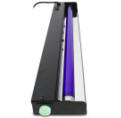A QUICK GUIDE TO
Ultra-Violet Blacklight

Often referred to as Longwave Ultra-Violet or ‘UV A’. Black lights are a specialised type of lighting unit that generates a safe form of UV light invisible to the human eye.
The frequency of UV light emitted by Black light units should ideally be 365-370nm; exactly the right frequency to make UV Revealing products such as STARGLOW UV Paints fluoresce brightly and energise Glow-in-the-Dark products, so they perform at their very best. Black lights are considered safe for use in the home as well as theatres and night clubs etc.
Besides the wide range of fun and artistic applications, there are several other more serious uses that black lights are particularly suited to detect:
- Counterfeit bank notes and IDs
- Repairs to Artwork & Antiques
- Leaks and structural weaknesses
- Dog & Cat urine stains
- General forgeries
- Vermin and certain insects
- Forensic crime scene examinations
- Environmental hygiene checks
- Hand hygiene training
Main types of UV light
The safest form of UV light and often referred to as Longwave UV, this kind of UV light is generated by Blacklight units (the dark purple fluorescent tubes) as well as UV LED Torches. It is a safe form of invisible UV light and is used to energise and activate the STARGLOW range of products. Most quality sunglasses will protect eyes against UV-A.
This particular kind of UV is the one that can cause sunburn if over exposed. It can also be used in the medical treatment of certain skin conditions. Most quality sunglasses will protect eyes against UV-B.
Totally absorbed by the Earths atmosphere, but widely used as a Germicidal steriliser in Hospitals. UV-C is source of UV you are unlikely ever to come across.
The ultimate goal of UV lighting is a pure 365nm UV output with zero visible light Interference (spill). This is not yet practical or affordable, so let price be your guide as to how close your choice of blacklight comes to achieving this.
Common Types of UV Blacklight

UV CANON

UV LED

UV BULB

UV STRIP

UV FORENSIC
Mainly used in larger UV Blacklight projectors such UV Canons and UV Floods, typically used in theatres and show venues where pure blacklight is required over a greater distance.
Most widely used of affordable blacklights, offering reasonable quality but with a very limited range (reach).
LED torches / Flashlights, uv-spots PARs and uv-floods. Powerful sources of UV blacklight usually at the high (weak) end of spectrum and generally emit large amounts of visible interference light.
UV-LED Blacklights
For most applications a certain amount of visible UV glare is acceptable which makes the basic UV units affordable. Fluorescent tube based black lights generally produce the best results when compare with LED based alternatives.
However, they only offer a short effective working range (illumination distance) and require mains-powered operation to deliver their best results, both of which limits their use and practicality.
LED torches and Flashlights generally produce a strong ‘UV beam’ best suited to illuminate ‘at a distance’ and are not usually suited to close-up work, owing to the higher visible-light ‘interference’ output, which tends to mask (or suffocate) the resulting fluorescence.
Higher Quality Forensic Torch with a lower visible output, may be used for both close-up and distance work. Let price be your guide and do not buy cheap UV LED torches expecting good results!
Remember – Lots of visible ‘Purple light’ (spill) is usually an indicator of POOR UV Quality!
The simple test below will enable you to find out into which frequency band your UV Torch belongs…
Torches operating in the wider 390nm – 405nm range generally use poor quality ‘cheap’ UV LEDs which produce too much unwanted visible ‘purple glare’ (spill) and too little in the way of a useful UV light. A general rule-of-thumb is the more LEDs the torch has, the lower the Quality of UV produced.
Avoid torches with more than 9 UV LEDs.
Torches outputting UV in the 380nm range perform much better and produce superior results, with a much reduced ‘visible’ (spill) output. Such units will naturally be more expensive than the cheaper 390-405nm models.
By stark contrast, the higher quality, more expensive torches producing the 365nm wavelength, produce a near pure UV output which is the optimum frequency for UV fluorescence. This means you will see far more detail and in a greater range of colours than any other wavelength. As these units generate less unwanted Interference light, they may naturally appear weaker or darker. This can be misleading and should not be misinterpreted.
As you can see from these examples of Blue, Red and Green, the best colour intensity and brightness comes from the 365-380nm UV Frequency range…




UV Torches are all the same. Right?
Wrong!
The ‘cheapo’ UV torch on the left (from the usual online sources) is a good example of what a UV light should NOT be…
It’s way too bright and way off-frequency. In short, the results (when not being drowned by excessive visible light!) are weak and washed-out due to poor quality UV LEDs.
The UV Forensic model in the middle however, represents a great price / performance balance, with much less visible light and high quality results from superior UV LEDs.
On the right. The UV PRO Forensic version has a special filter which removes all visible light, so you get amazing vivid results without any visible light interference.
How to test a UV Blacklight
In this following demonstration, which use an old British £20 note, it is possible to see the visual differences between the UV wavelengths and is therefore a simple and effective way of testing (or determining) the approximate operating wavelength of a UV LED torch or UV lamp.




This video test shows the differences in UV quality between 3 types of UV LED Torch.
If you need help or advice, please call or email us. We are here to help you.
